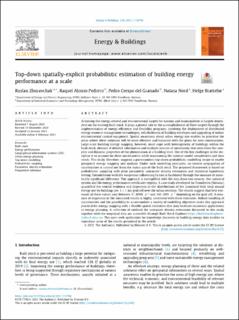| dc.contributor.author | Zhuravchak, Ruslan | |
| dc.contributor.author | Pedrero, Raquel Alonso | |
| dc.contributor.author | Crespo del Granado, Pedro | |
| dc.contributor.author | Nord, Natasa | |
| dc.contributor.author | Brattebø, Helge | |
| dc.date.accessioned | 2021-09-10T06:28:09Z | |
| dc.date.available | 2021-09-10T06:28:09Z | |
| dc.date.created | 2021-02-11T13:45:36Z | |
| dc.date.issued | 2021 | |
| dc.identifier.citation | Energy and Buildings. 2021, 238 . | en_US |
| dc.identifier.issn | 0378-7788 | |
| dc.identifier.uri | https://hdl.handle.net/11250/2775060 | |
| dc.description.abstract | Achieving the energy-related and environmental targets for nations and municipalities is largely dependent on the existing built stock. It plays a pivotal role in the accomplishment of these targets through the implementation of energy efficiency and flexibility programs, involving the deployment of distributed energy resource management technologies, refurbishment of building envelopes and upgrading of indoor environmental control equipment. Spatial awareness about urban energy use enables to prioritise the areas where these solutions will be most effective and balanced with the plans for new constructions. Large-scale building energy mapping, however, must cope with heterogeneity of buildings within the built stock, absence of detailed information and multiple sources of uncertainty that stem from the complex and dynamic properties of the phenomenon at a building level. One of the key challenges in the discipline is to account for these uncertainties while maintaining the rational model complexities and data needs. This study, therefore, suggests a parsimonious top-down probabilistic modelling recipe to enable geospatial energy mapping and analysis. Under such modelling principles, an inverse propagation of uncertainties is carried out from the status quo of the built stock. The proposed framework is based on probabilistic sampling with prior parametric univariate density estimation and statistical hypothesis testing. Consolidation with the exogenous influencing factors is facilitated through the measure of statistically significant difference. This approach is exemplified with the data from two sources: the cadastral system and the energy performance certificates registry. A case study developed for Trondheim (Norway) quantified the central tendency and dispersion in the distributions of the simulated bulk total annual energy use by buildings per | en_US |
| dc.language.iso | eng | en_US |
| dc.publisher | Elsevier | en_US |
| dc.rights | Navngivelse 4.0 Internasjonal | * |
| dc.rights.uri | http://creativecommons.org/licenses/by/4.0/deed.no | * |
| dc.title | Top-down spatially-explicit probabilistic estimation of building energy performance at a scale | en_US |
| dc.type | Peer reviewed | en_US |
| dc.type | Journal article | en_US |
| dc.description.version | publishedVersion | en_US |
| dc.source.pagenumber | 11 | en_US |
| dc.source.volume | 238 | en_US |
| dc.source.journal | Energy and Buildings | en_US |
| dc.identifier.doi | 10.1016/j.enbuild.2021.110786 | |
| dc.identifier.cristin | 1888867 | |
| dc.relation.project | Norges forskningsråd: 268248 | en_US |
| cristin.ispublished | true | |
| cristin.fulltext | postprint | |
| cristin.fulltext | original | |
| cristin.qualitycode | 2 | |

